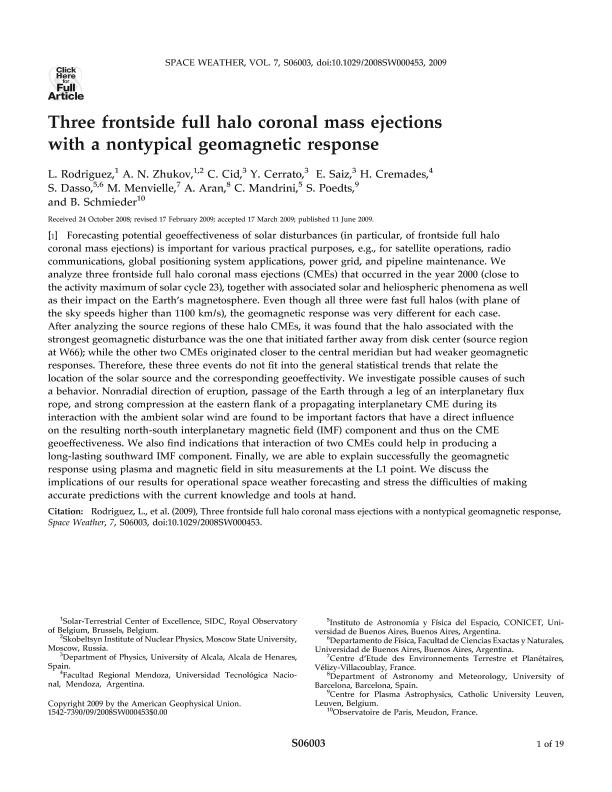Mostrar el registro sencillo del ítem
dc.contributor.author
Rodriguez, L.
dc.contributor.author
Zhukov, A. N.
dc.contributor.author
Cid, C.
dc.contributor.author
Cerrato, Y.
dc.contributor.author
Saiz, E.
dc.contributor.author
Cremades, H.
dc.contributor.author
Dasso, Sergio Ricardo

dc.contributor.author
Menvielle, M.
dc.contributor.author
Aran, A.
dc.contributor.author
Mandrini, Cristina Hemilse

dc.contributor.author
Poedts, S.
dc.contributor.author
Schmieder, B.
dc.date.available
2017-08-04T21:39:51Z
dc.date.issued
2009-06
dc.identifier.citation
Rodriguez, L.; Zhukov, A. N.; Cid, C.; Cerrato, Y.; Saiz, E.; et al.; Three frontside full halo coronal mass ejections with a nontypical geomagnetic response; American Geophysical Union; Space Weather-the International Journal Of Research And Applications; 7; 6; 6-2009; 1-19
dc.identifier.issn
1542-7390
dc.identifier.uri
http://hdl.handle.net/11336/21930
dc.description.abstract
Forecasting potential geoeffectiveness of solar disturbances (in particular, of frontside full halo coronal mass ejections) is important for various practical purposes, e.g. for satellite operations, radio communications, global positioning system applications, power grid and pipeline maintenance. We analyze three frontside full halo coronal mass ejections (CMEs) that occurred in the year 2000 (close to the activity maximum of solar cycle 23), together with associated solar and heliospheric phenomena as well as their impact on the Earth?s magnetosphere. Even though all three were fast full halos (with plane of the sky speeds higher than 1100 km/s), the geomagnetic response was very different for each case. After analyzing the source regions of these halo CMEs, it was found that the halo associated with the strongest geomagnetic disturbance was the one that initiated farther away from disk center (source region at W66); while the other two CMEs originated closer to the central meridian but had weaker geomagnetic<br />responses. Therefore, these three events do not fit into the general statistical trends that relate the location of the solar source and the corresponding geoeffectivity. We investigate possible causes of such a behavior. Non-radial direction of eruption, passage of the Earth through a leg of an interplanetary flux rope and strong compression at the eastern flank of a propagating ICME during its interaction with the ambient solar wind are found to be important factors that have a direct influence on the resulting north?south interplanetary magnetic field (IMF) component and thus on the CME geoeffectiveness. We also find indications that interaction of two CMEs could help in producing a longlasting southward IMF component. Finally, we are able to explain successfully the geomagnetic response using plasma and magnetic field in situ measurements at the L1 point. We discuss the implications of our results for operational space weather forecasting and stress the difficulties of making accurate predictions with the current knowledge and tools at hand.
dc.format
application/pdf
dc.language.iso
eng
dc.publisher
American Geophysical Union

dc.rights
info:eu-repo/semantics/openAccess
dc.rights.uri
https://creativecommons.org/licenses/by-nc-sa/2.5/ar/
dc.subject
Space Weather: Forecasting
dc.subject
Space Weather: Magnetic Storms
dc.subject
Space Weather: Solar Effects
dc.subject
Space Weather: General or Miscellaneous
dc.subject.classification
Astronomía

dc.subject.classification
Ciencias Físicas

dc.subject.classification
CIENCIAS NATURALES Y EXACTAS

dc.title
Three frontside full halo coronal mass ejections with a nontypical geomagnetic response
dc.type
info:eu-repo/semantics/article
dc.type
info:ar-repo/semantics/artículo
dc.type
info:eu-repo/semantics/publishedVersion
dc.date.updated
2017-07-28T15:05:34Z
dc.journal.volume
7
dc.journal.number
6
dc.journal.pagination
1-19
dc.journal.pais
Estados Unidos

dc.journal.ciudad
Washington
dc.description.fil
Fil: Rodriguez, L.. Royal Observatory of Belgium; Bélgica
dc.description.fil
Fil: Zhukov, A. N.. Royal Observatory of Belgium; Bélgica
dc.description.fil
Fil: Cid, C.. Universidad de Alcalá; España
dc.description.fil
Fil: Cerrato, Y.. Universidad de Alcalá; España
dc.description.fil
Fil: Saiz, E.. Universidad de Alcalá; España
dc.description.fil
Fil: Cremades, H.. Universidad Tecnologica Nacional; Argentina
dc.description.fil
Fil: Dasso, Sergio Ricardo. Consejo Nacional de Investigaciónes Científicas y Técnicas. Oficina de Coordinación Administrativa Ciudad Universitaria. Instituto de Astronomía y Física del Espacio. - Universidad de Buenos Aires. Facultad de Ciencias Exactas y Naturales. Instituto de Astronomía y Física del Espacio; Argentina
dc.description.fil
Fil: Menvielle, M.. Centre d’Etude des Environnements Terrestre et Planetaires; Francia
dc.description.fil
Fil: Aran, A.. Universidad de Barcelona; España
dc.description.fil
Fil: Mandrini, Cristina Hemilse. Consejo Nacional de Investigaciónes Científicas y Técnicas. Oficina de Coordinación Administrativa Ciudad Universitaria. Instituto de Astronomía y Física del Espacio. - Universidad de Buenos Aires. Facultad de Ciencias Exactas y Naturales. Instituto de Astronomía y Física del Espacio; Argentina
dc.description.fil
Fil: Poedts, S.. Catholic University Leuven; Bélgica
dc.description.fil
Fil: Schmieder, B.. Centre National de la Recherche Scientifique. Observatoire de Paris; Francia
dc.journal.title
Space Weather-the International Journal Of Research And Applications

dc.relation.alternativeid
info:eu-repo/semantics/altIdentifier/url/http://onlinelibrary.wiley.com/doi/10.1029/2008SW000453/abstract
dc.relation.alternativeid
info:eu-repo/semantics/altIdentifier/doi/http://dx.doi.org/10.1029/2008SW000453
Archivos asociados
